Long-range patrol fighter-interceptor Tu-128 (Part of 2) Mass production and modifications
Contrary to tradition, mass production unfolded almost simultaneously with the construction of an experimental specimen. There was a certain risk in this in the case of the appearance of major technical problems with the prototype, but this approach gave a great time saving in terms of implementation and development of the complex. From the end of 1959, even without waiting for factory tests, the construction of an installation batch of four serial interceptors began in Voronezh. 13 May 1961. The first production car took off. Factory testing of the first cars continued until the end of the year. 20 March 1962 began a joint state test, which was already attended by five aircraft. Pilots N. Korovushkin and Y. Rogachev flew at them from the Air Force, as well as navigator N. Mozgovoy. Together with the crews of the OKB, they performed a large number of test flights, confirming the good flight qualities of the aircraft and the viability of the entire complex.
True, sometimes a new plane gave surprises. In the next test flight, the aircraft, piloted by Rogachev and Brain, at an altitude of 11 800 m lost stability and began to randomly fall. It was only thanks to the exceptional courage and skill of the pilot at the height of 2000 that he was able to take him to horizontal flight and then safely land on the airfield. Throughout the fall, Rogachev transmitted to the command post information about the behavior of the interceptor and about all its actions. For this flight, the crew was awarded orders. Then, we analyzed the records of the onboard KZA and, using the information received, developed measures to improve the stability and controllability characteristics of the aircraft.
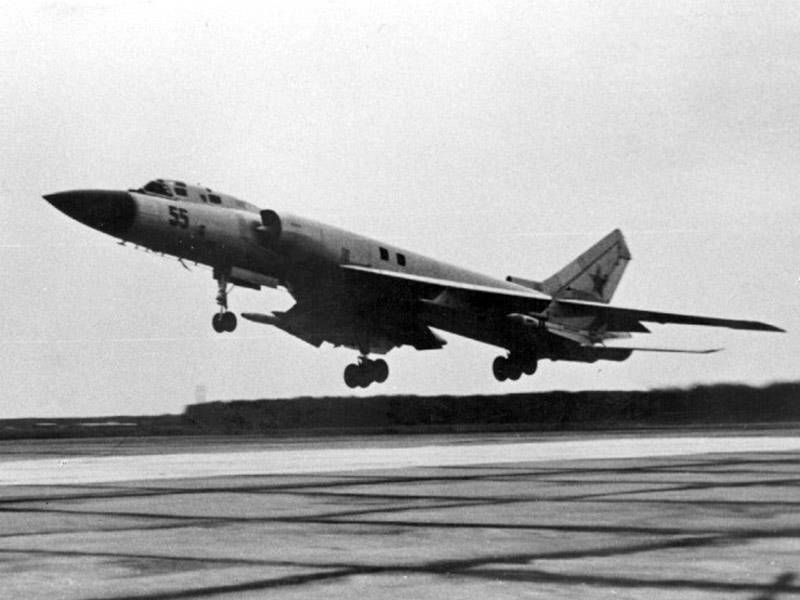
Soon, with the release of new mass-produced machines, the pilots and air navigators I. Lesnikov, E. Knyazev, G. Beregovoy (the future pilot-cosmonaut), N. Malygin and others joined the joint tests. In parallel with the tests, the Design Bureau and related enterprises continued to bring and improve the complex. In August, 1962 began flights to intercept real targets. September 27 1962. The IL-28М target was shot down from a plane by a rocket, in October a high-altitude target based on the Yak-25РВ scout. Based on these first successful interceptions, in November of the same year, a decision was made to deploy the full-scale production of the Tu-28 aircraft, the K-80 missiles and the rest of the elements of the Tu-28-80 complex. 12 December 1963 The Minister of Defense changed the name of the complex to Tu-128С-4, the aircraft to Tu-128, the missiles to P-4Р and Р-4Т (from radar and thermal seeker, respectively). Due to the complexity and novelty of the elements of the complex, its testing and refinement took almost three years. During this time, 799 performed test flights, including a large number - with missile launches on target aircraft.
During the tests of the complex, they received data that basically confirmed the expectations of the developers and the command aviation Air defense, opening the way for him to adopt. Tu-128 with four missiles developed a top speed of 1665 km / h, without missiles - 1910 km / h, had a practical range of 2565 km, practical ceiling of 15 600 m; the complex provided an interception line of 1170 km, a barrage time of 2,75 hours, a target radar detection range of 50 km, a range of altitude flight targets - 8000 - 21 000 m, maximum missile launch range - 25 km.
In the summer of 1964, the test program of the complex was basically completed. Based on the results of years of testing 30 on April 1965, the Tu-128-4 complex was adopted by air defense aviation.
Before 1965, Plant No. 64 produced all 12 machines that were continuously updated. They were used in various test programs, as well as for training flight and technical personnel in an air defense training center. The full-scale mass production of the Tu-128 and the entire Tu-128-4 complex unfolded in 1966, when the plant launched 42 machines, of which 37 were handed over to the customer. In total, from 1961 to 1970, the plant built 187 interceptors (plus one prototype made at plant No. 156) and in 1971, the 10 production Tu-128UT training machines.
With the start of operation of the Tu-128, it became clear that for a quick and trouble-free retraining of flight personnel it was necessary to create on its base a specialized training airplane. After all, combatant fighter pilots were transferred to the Tu-128, having experience of flying only on the MiG-17, MiG-19 and MiG-15bis, rarely - Su-9, without any skills of piloting heavy aircraft. At first, Tu-124X were used for training flight personnel in the units, which were intended for training long-range and front-line bomber aviation crews. In September, the 1966 of the OKB received a task to develop a training modification of the Tu-128UT (I-UT aircraft). The project was prepared in the Voronezh branch of the OKB under the leadership of A.I. Putilova. The main difference between the Tu-128UT and the combat interceptor was the presence of an instructor's cabin installed at the radar site. The contours of the cockpit went beyond the contours of the front of the aircraft, forming a semblance of pelican goiter, for which the Tu-128UT, barely appearing on the airfield, received the nickname "Pelican". The position of the navigator-operator was preserved, but its functions, due to the absence of the radar, were limited only to solving navigation tasks. For practicing skills to intercept air targets under the wing left pylons, on which it was possible to hang either mass-dimensional mock-ups of missiles, or training versions of the P-4T missiles. Otherwise, in terms of their basic systems and equipment, the Tu-128UT was fully consistent with the design of the Tu-128.
Due to the loading of the branch in series and with the beginning of work on the modification of the Tu-128, the creation of the Tu-128UT was delayed. Only in August, 1970 decided to allocate four production aircraft for conversion into a training version. In a short time, the converted machines successfully passed the tests; in September, the 1971 of the Tu-128UT was adopted. In the same year, plant number 64 built two series of five aircraft, they differed from the first samples with an improved overview from the instructor's cabin and a new keel.
The Tu-128-4 complex was laid in 1958, and was put into service in 1965. During this period, the air strike equipment of the NATO countries reached a new qualitative level. The development of pilotage-navigation and sighting systems allowed attack aircraft to proceed to combat operations at low altitudes, which significantly reduced the effectiveness of the available air defense systems designed in the 1950-ies. and intended mainly to hit targets at high and medium altitudes. Even during the design and development of the Tu-128C-4 complex, the Tupolev Design Bureau, together with other developers, began searching for ways to upgrade it.
The possibility of increasing the aircraft’s power supply with the aim of improving flight performance was studied. The following types of engines were considered as alternative types: AL-7F-4 (with maximum static load 11 OOO KG), Р-15Б-300 (15 000 kg), РД-15 (13 000 kg),
RD-19P-2 (kg 14 200) and RD-36-41 (kg 16 000). To improve the take-off characteristics, a launch was proposed using solid-fuel boosters from the unmanned reconnaissance Hawk (Tu-123).
At the beginning of 1963, on one of the serial Tu-128, experimental TRD AL-7F-4 was installed; At the same time, in order to improve the characteristics of the transverse control at supersonic speeds, they introduced interceptors. In February, they launched test flights with new engines, and in 1967, the AL-7F-4 was replaced with the upgraded AL-7F-4Г. With the latest aircraft with full suspension reached a speed corresponding to M = 1,6. But because of the lack of knowledge of new engines, these works did not receive further development.
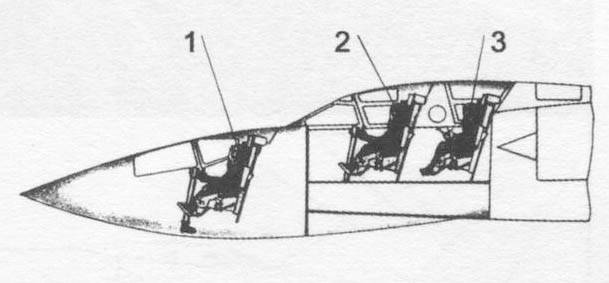
The possibility of choosing systems based on the RP-SA (Smerch-A) and Thunder-100 type radars developed at that time was considered as a promising weapon system. At the same time, work was underway to modernize the K-80 missiles, bringing their launch range to 32 km (K-80M) and the new K-100 missiles.
These studies became the basis for the project Tu-28A. As the power plant for him chose two TRD VD-19. The complex with RP-SA radar and K-80M missiles received the designation Tu-28А-80. It was supposed to provide interception lines to 2000 km and loitering time to 4 h. The target detection range increased to 100 km, the missile launch range increased to 32 km. It was possible to hit a chain flying at speeds up to 3000 km / h at altitudes up to 26 000 m. The maximum speed of the interceptor itself increased to 2100 - 2400 km / h. The second variant of the complex, the Tu-28А-100 with the K-100 missiles, corresponded in its characteristics to the Tu-28А-80, with the exception of the target detection range increased to 200 km, the missile launch range - to 100 km, and the ceiling of intercepted chains (to 30 LLC m). According to the program to create a Tu-28 in 1962 - 1963. We have worked out several options for upgrading the Tu-28 for VD-19 engines and new radars. In its original form, the Tu-28A had to almost completely repeat the Tu-28 and differ from it with the tail section expanded for new larger engines, enlarged air intakes with multi-mode central bodies, expanded engine air supply channels, increased due to the installation of the radar, nasal part of the fuselage and the introduction to maintain the normal travel stability of the fuselage-crests. Later, the Tu-128A project with side flat oblique air intakes with a horizontal wedge appeared.
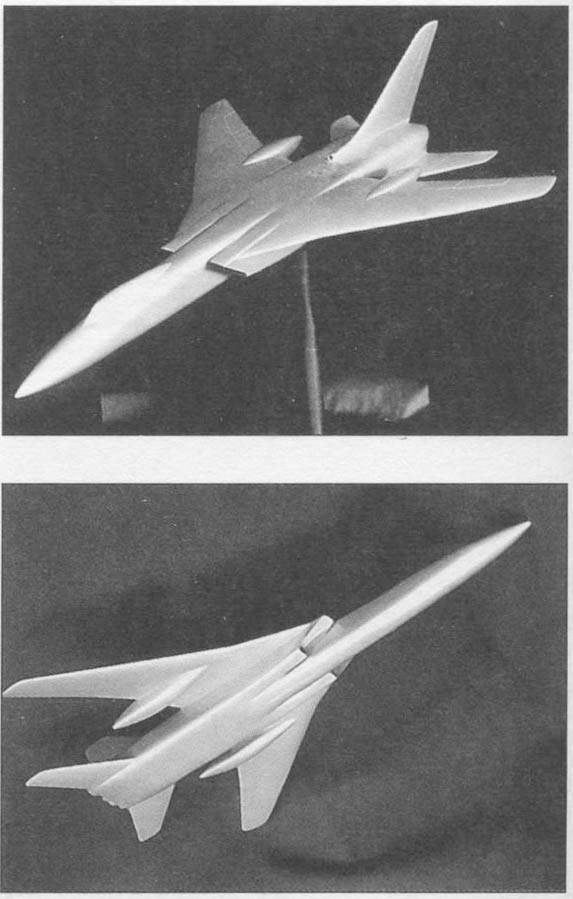
At the beginning of 1964, the WD-19 passed bench tests with air inlets from the Tu-28, and in 1965, it was tested on the Tu-128LL, converted from the serial Tu-128. The Tu-128LL aircraft was to be the prototype of the Tu-128А; in addition to more powerful engines, it installed a new nose of the fuselage and the weight equivalent of the Smerch-A RP-SA radar. The first flights showed that the VD-19 required refinement and, in addition, the increased midsection of the fuselage at the expense of larger engines "ate" most of the additional thrust. As a result, Tu-128LL even without suspensions could not exceed the speed of 2000 km / h. At this work on the Tu-XNUMHA and Tu-28A ended.
Experience has shown that attempts to develop the complex only by increasing the thrust and introducing the latest radar and rocket systems cannot fully meet the increased requirements - a radical modernization of the aircraft carrier was necessary. In 1963, work began on two new complexes based on the 138 aircraft project (Tu-138). Electronics and rocket armament took almost unchanged compared with the Tu-28A. Two options were being worked out: the Tu-138-60 with the Smerch-A radar and the new K-60 and the Tu-138-100 with the Groz-100 radar and the K-100. Designers focused on improving flight performance due to significant changes in the aerodynamics of the aircraft. In order to achieve high speeds with the same power plant (based on WD-19), the Tu-138 was first chosen with a wing with a reduced relative thickness, but with preservation of the basic aerodynamic and layout solutions of the Tu-28А. Then they moved to an aerodynamically “clean” wing without fairings of the main landing gear, which were now retracted into the wing and into the fuselage, which reduced the available volumes for fuel. According to the 138 project, models were made and blown through them in TsAGI wind tunnels. The results of purging and additional calculations showed that aerodynamic improvements make it possible to obtain the required maximum speeds. However, a decrease in the aerodynamic quality at cruising speeds on subsonic flights, combined with a reduction in fuel reserves, subject to weight limits, led to a significant reduction in subsonic flight range and, consequently, possible interception limits. They tried to solve the problem by refueling in flight and increasing the fuel supply. At the same time, in order to improve the take-off characteristics, a system for blowing off the boundary layer from the flaps and toe of the wing was introduced. But this further increased the mass of the empty aircraft and reduced all attempts to increase the range to almost zero.
In addition to the usual layout, close to the Tu-128, offered a few exotic. There were variants of the aircraft "138" in the form of a "flying wing" and made under the "duck" with a triangular wing, as well as a number of others.
The problem with the range for the Tu-138 continued to be relevant. It required a revolutionary technical solution that could make the aircraft multi-mode, having an aerodynamic layout, at the same time meeting the requirement of achieving high supersonic speeds and at the same time capable of providing greater flight range at subsonic speed. Such a revolutionary decision was the use of the wing swept variable in flight.
Work on the 148 (Tu-148) began in 1965 in parallel with the 145 project, the future Tu-22M bomber. In the fall, the Design Bureau decided on the main characteristics of the complex and its potential capabilities. The use of a variable sweep wing in combination with two turbojet engines VD-19Р2 made it possible to resolve many contradictions of previous projects and significantly expand the possibilities of tactical use of the aircraft. It was expected to get when flying at altitudes 50 - 100 m speed 1400 km / h and at altitudes 16 000 - 18 000 m - 2500 km / h. With the swept wing, corresponding to the cruise flight on the subsound, the range 4800 km was ensured. When refueling in flight, the indicators for range, depending on the flight mode, increased by 30 - 40%. The take-off and landing characteristics, even with an increase in the take-off weight of the Tu-148 to 55 - 60 (YTu-128 - 43), were much better than the Tu-128: the length of the 800 m run and the use of third-class airfields with unpaved runways (for Tu 128 - 1350 m and second class, respectively).
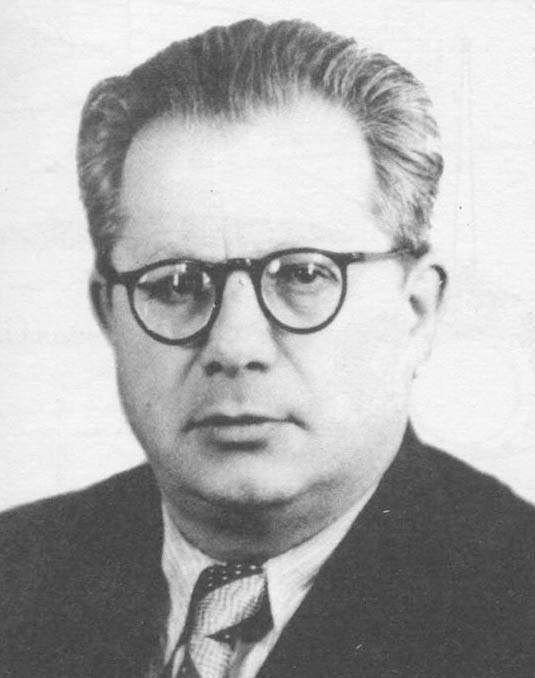
With some re-equipment, the Tu-148 could be used to disrupt air transportation in the enemy’s operational rear (as a self-summer “raider”), to provide air defense to surface ships at large distances from bases, as a carrier of air-to-surface missiles including those with passive GOS to destroy ground-based radars and early warning airplanes, as a reconnaissance radio equipment, low-altitude and high-altitude photo reconnaissance, tactical bomber carrying nuclear and conventional bombs, as well as attack aircraft, armed with P and guns, for operations on land in areas with relatively weak air defense at sea against small ships. In fact, it was about creating a multi-purpose aircraft. The second highlight of the project was the proposal to use a combined heat radiolocation control system weapons “Smerch-100”, which included quasi-continuous radar radar with a phased antenna with a diameter of 2 m, radar detection and tracking equipment, coupled with radar, digital on-board computer and side-looking radar antennas. Developers of the Smerch-100 system promised to provide the detection range of air targets like the Tu-16 bomber when attacking from the front hemisphere to 3500 km, the detection range for side searching - to 600 km, and the direction finder distance on directional courses to 100 km. The system was supposed to ensure the launch and control of missiles in the search mode from a range of 250 km when attacking from the forward hemisphere. For those times, such characteristics seemed on the verge of fiction and in the case of successful creation of the system they could solve problems with long-range interception systems for many years.
Production of Tu-128 aircraft by plant No. 64 for the period from 1961 to 1971.
| years | 1961 | 1962 | 1963 | 1964 | 1965 | 1966 | 1967 | 1968 | 1969 | 1970 | 1971 | TOTAL |
| Issue | 2 | 2 | 2 | 3 | 4 | 42 | 37 | 31 | 38 | 27 | 10 | 198 |
Total plant number 64 released 198 aircraft type Tu-128. One experimental machine produced plant number 156. One glider Tu-128 plant number 64 manufactured for static tests. The total production of Tu-128 type airplanes was 200 instances, of which: five serial Tu-128 were converted into Tu-128UT; ten Tu-128 were released by the plant number 64 in the version of the Tu-128UT; Two Tu-128 airplanes were produced by plant No. 64 in the Tu-128M variant; in the future, all the modifications to the Tu-128С-4М complex were carried out by air defense repair plants.
At the first stage, it was planned to equip the complex with K-100 missiles with a combined heat and radar radar GPS, various types of warheads and an 80 km launch range, further, since the capabilities of the Smerch-100 system allowed it, they wanted to go on missiles with a longer range. The system was capable of destroying targets flying at altitudes from 50 to 32 000 - 35 000 m with speeds from 500 to 4000 - 4500 km / h. The on-board equipment included a trajectory control system, an NSP complex providing autonomous navigation, a unified automatic system for receiving information about targets, commands from control points, guidance and transmission of information to other aircraft, a low-altitude flight system. All weapons and special equipment housed in the fuselage cargo compartment. Multi-purpose use of the Tu-148 suggested a quick transition from one option to another directly in the conditions of the front part. Cargo compartments with replaceable modules were calculated on the following boot options: four K-100 missiles; one X-22 or two X-28, or four K-100P; the apparatus of electronic reconnaissance "Bulat", or "Saber", or "Virage"; “Diamond”, PAFA and AFA-42 / 20 cameras plus an additional fuel tank or AFA-42 / 20, two AFA-54 and AFA-45; two tactical nuclear bombs or containers with NURS, or with aircraft guns with ammunition. In the long-range interceptor variant, the Tu-148-100 complex could provide the interception line of 2150 km to dial-up, to 2500 km at speed of 1000 km / h and to 1700 km at combined mode. The barrage time at the turn of 1300 km reached 2 h, and at 500 km it reached 4 h, which made it possible to reliably cover the northern and eastern regions of the country with relatively small forces and means. In addition to these missiles, the B-148 rocket was created specifically for this complex in the Fakel Design Bureau.
In case of success, the air defense project could receive highly efficient weapons. But his weak point was the high saturation of the most advanced equipment. Given the level of development of the radio-electronic industry in the USSR in the 1960-s, it can be concluded that a similar complex could appear, under the most favorable conditions, at least ten years later. This was confirmed in practice: a much simpler and less efficient complex based on the Zaslon system was released only in the 1970s.
The direction to create a multi-purpose vehicle capable of performing both an interceptor function and a front-line striking machine was also not in line with the development policy of the domestic Air Force, which, unlike the Americans, sought to have several types of narrowly specialized aircraft, and not multi-purpose combat vehicles. As a result, the Tu-148 project, in this configuration, did not arouse any interest from the Air Force command and did not receive further development.
Work on the Tu-148 was somewhat revived in the second half of the 1960-s, when they began to create a new weapon system "Barrier" with K-33 missiles (110 detection range - 115 km, 80 launch range - 90 km), with structure and functionality close to “Tornado-100”, but having much more modest capabilities and, accordingly, more real from the point of view of its implementation. It was decided to abandon the idea of creating a multi-purpose aircraft for the Air Force and concentrate fully on the long-range interception complex.
Basic data of Tu-128 aircraft and complexes based on them
| Modification | Tu-128 | Tu-128M | TU-128UT |
| Year of construction | 1961 | 1970 | 1970 |
| The number and type of TRDF | 2AL-7F-2 | ||
| Maximum thrust, kg: afterburner afterburner | 2x10100 2x6800 | ||
| Aircraft Length m | 30.06 30,58 | ||
| Wingspan, m | 17,53 | ||
| Height, m | 7,15 | 7,07 (with P-846) | 7,15 |
| Maximum take-off weight, t | 43,0 | 43,26 | 43.0 |
| Empty mass, t | 25,96 | 25,85 | |
| Maximum speed, km / h: with missiles without rockets | 1665 1910 | 1450 | |
| Flight distance, km | 2565 2460 | 2230 | |
| Practical ceiling, m | 15 600 | 14 100-15 000 | |
| Runway length, m | 1350 | ||
| Run length, m | 1050 | ||
| Crew. | 2 | 2-3 | |
| Radar type detection range, km capture range, km | Tornado 50 35-40 | Smerch-M 50 35-40 | — |
| The number and type of missiles | 2xP-4T, 2xP-4P | 2xP-4TM, 2xP-4PM | — |
| Frontier pickup, km | 1170 | ISO | — |
| Loitering time, h | 2,75 | 2,6 | — |
| The height range of target destruction, m | 8000 — 21 000 | 500 — 21 000 | — |
| Maximum target excess, m | 7000-8000 | — | |
| Maximum range of missile launch, km | 20-25 | — | |
Expansion of combat capabilities and increasing the effectiveness of the complex compared to the Tu-128С-4 was achieved by improving the flight and tactical and technical characteristics. The minimum altitude of the intercepted targets was reduced from 8 to 0,05 km. It was planned to intercept small-sized targets (Hound Dog airborne missiles, SRAM, SCAD and SCAM) with detection on the background of the terrain. The speed of targets in the forward hemisphere could reach 3500 km / h, and in the rear - to 2300 - 2400 km / h. The target's target height increased from 21 000 m to 26 000 - 28 000 m. It was planned to increase the noise immunity, ensure the simultaneous attack of two targets and group actions.
They also hoped to increase the effectiveness of semi-autonomous and autonomous operations, increase the range and duration of the flight, improve the take-off and acceleration characteristics, and improve the automation of the main stages of the flight. It was planned to replace the AL-7F-2 engines with more powerful RD-36-41, refine the fuselage, redesign the air intakes and their channels, install a new wing with variable sweep, slats and twin-slit inner flaps, reinforce the chassis and introduce new wheels, introduction interceptor control and automatic stability of the path, as well as trajectory control systems. The modified aircraft had to be operated from the same airfields as the Tu-128.
The OKB presented a draft to the country's Air Defense Command, and he received the support of the Commander-in-Chief of Air Defense Aviation Kadomtsev. The design bureau immediately began work on designing the aircraft and the complex. Prepared a full-size model of the Tu-148, which was several times examined by representatives of the customer.
But in May 1968 of the city of Kadomtsev died in a plane crash. And the new leadership of the air defense aviation preferred to upgrade the serial interceptor MiG-25П to the Zaslon system; At the same time, work began on the E-155MP aircraft (with the same “Shield”) - the prototype of the future serial MiG-31. However, formally, the Air Defense Command did not for some time refuse from the Tu-148 project. But additional requirements were made to the aircraft, which in many respects went against the concept of the machine itself and the entire complex. One of these requirements was a significant improvement in the maneuverability of the Tu-148 at low altitudes. Tupolev persistently tried to break the attitude towards his brainchild and make an official decision on the complex, and most importantly - to allocate money for further design, but all was in vain. At the beginning of the 1970's the work had to finally collapse.
Since the attempts to deeply upgrade the Tu-128С-4 complex undertaken in the 1960-s did not work for various reasons, they decided to carry out a small modernization of the complex in order to expand its capabilities to combat targets flying at low altitude. In 1968, a corresponding government decision appears. The new complex received the designation Tu-128С-4М, and the aircraft - Tu-128М (aka "IM"). The new version of the interceptor was equipped with an improved on-board radar RP-SM ("Smerch-M") and the R-4РМ and Р-4ТM missiles. The objectives were to reduce the minimum height of intercepted targets from 8 to 0,5 - 1,0 km and to improve noise immunity in the conditions of use of the REB by the enemy. The main burden of work on the modernization of the complex fell on the developers of the radar, missiles and their GOS.
In November 1969, the Tupolev Design Bureau transferred to the plant No. 64 the documentation necessary for the modernization. Air defense aircraft identified two recent Tu-128 series. In August - September, 1970, both vehicles, after revision, were accepted for joint tests, which lasted until the end of July, 1974. Then, for another five years, comments were eliminated, and finally, in June, the X-NUMX complex Tu-1979-128M was adopted . This delay was mainly due to the complexities of fine-tuning radar and missiles.
In the modification of the Tu-128M retooled serial interceptors received from the air defense units. Work went on repair factories of the Air Force. In a relatively short period, almost all of the available Tu-128 were upgraded.
Considering the capabilities of the Tu-128 to carry combat cargoes on the external sling, they tried to adapt it for strikes against ground targets. In 1963, the option of arming the aircraft with NUR C-5K or C-5М, NUR C-24, AO-9 gun guns, 250 caliber 500 kg was considered. At the same time, an ASP-PF sight (from the MiG-21PF fighter) was to be mounted in the cockpit. Later, the possibility of carrying X-28 or K-80P anti-radar missiles was studied. Also, the possibility of suspension of KCR missiles of various reconnaissance equipment and so on was being explored.
In 1969, the bureau was engaged in the modification of the Tu-128B - a front bomber. A bomber sighting equipment was placed on the aircraft, the bomb storage compartment on the 1,5 t bombs was allocated in the fuselage, another 3 t bombs could be placed on the external suspension on pylons under the wing. The installation of REB equipment was also planned. Without external suspensions, the maximum speed of the Tu-128B at an altitude of 11 000 m was 1770 km / h and the practical flight range was 2345 km, with the suspensions the speed dropped to 1210 km / h and the range to 1430 km. Air Force machine is not interested, preferring the Su-24.
TECHNICAL DESCRIPTION
The Tu-128 aircraft was the main part of the Tu-128-4 long-range interception of aerial targets.
The main structural materials of the airframe are aluminum alloys D-16 and B-95 (sheets, profiles and stampings), steel alloys ZOHGSA and ZOHGSNA (loaded and docking assemblies, fasteners), magnesium alloy MlNNXX-25 (in the form of various molded parts) and others. Basically, the design is riveted, with extensive use of paneling in various airframe units.
The fuselage of the aircraft is a semi-monocoque design, carried out taking into account the "space rule". It consists of four main power units: bow, front, middle and tail. The nose section continued up to the 11 frame and consisted of three technologically independent compartments: a nose fairing, a front compartment and a crew press cabinet that was located between the 4 and 11 frames. The crew got into the cabin through opening up the lantern covers. Windshields were made of silicate glass, the side and top - of heat-resistant plexiglass.
The front of the fuselage continued to the 25 frame. It housed a niche of the front landing gear support, a technical compartment above the niche, and air intakes with movable electrically-controlled cones regulating the inlet section area.
In the middle part of the fuselage between the 25 and 32 frames below the building horizontal of the fuselage there was a wing center section. Along both sides of the air to the 45 frame were air channels from the air intakes to the TRDF. Between the 26 - 27 and 28 - 29 frames on their outer surface were additional sash air make-up engines that opened in take-off modes at an angle 37 °.
The tail of the fuselage (from the 49 frame to the 57) was occupied by an afterburner TRDF. In the area of the 53 - 57 frames, there were four air intakes, which provided air to blow the spaces between the afterburner chambers and the fuselage skin. To reduce the length of the landing run in the tail section, a brake parachute with an area of 50 m 2 with an electropneumatic release system was stored in a special container.
The wing of the two-spar design consisted of a center section, two middle and two detachable parts. The wing mechanization included flaps, ailerons and spoilers. Inside the center section there were two soft unprotected fuel tanks. The design of the center section is riveted. The middle part was a caisson tank. The main landing gear, the mechanisms for cleaning them and the gondola where they fit, as well as the pillars for the suspension of the rockets, were attached to it. Two aerodynamic ridges were installed on the upper surface of the wing. The panels of the middle part of the wing are pressed, the spars and the tail boom of the power set are riveted. The detachable part of the wing had riveted panels. On it were mounted ailerons, which had axial compensation and trimmers with an electromechanical drive.
The tail plumage consisted of a keel with a rudder and an in-flight stabilizer with a rudder. In front of the forquil, there was an air intake for blowing the afterburner chambers of the turbofans and blowing electrical generators. The keel was attached to the fuselage on four nodes to the 51 and 55 frames. Both stabilizer surfaces were attached to the 55 frame in the bearing assemblies. The keel and stabilizer - two-spar design. All steering wheels had aerodynamic compensation and weight balancing. The rudder was supplied with an electric trimmer.
The aircraft landing gear included a two-wheeled bogie front leg and two main four-wheeled bogies. Depreciation of support struts - oil-pneumatic. The pressure in pneumatic wheels is 11 kg / cm2. Cleaning and production of the chassis, as well as the braking wheels provided hydraulic system of the aircraft. The front wheels are without brakes, 600 x 155 mm in size, the main ones are brake brakes 800 x 225 mm in size. The front desk was equipped with a “shimmy” damper mechanism, the executive elements of which were also used to control the rack during taxiing. In the system of brake wheels there was an anti-automatic automatics. The main pillars in flight were removed in the wing gondola, the front - in a niche in front of the fuselage.
The power plant consisted of two single-circuit turbojet engines with an afterburner (TRDF) type AL-7F-2 with a maximum thrust at the afterburner each 10 100 kg with specific fuel consumption 2,25 kg / kgch. The maximum unforgiven thrust was equal to 6900 kg with a specific fuel consumption 0,95 kg / kgh. Dry weight of one engine with 2454 units installed on it kg. The TRDF was launched from the TS-20B turbo starter mounted on the engine.
Side air intakes had mechanization in the form of a rolling cone and flaps of additional air intake. During the take-off of the aircraft, the cone was in the extreme rear position, and the makeup flaps were open. After takeoff, the shutters closed, and the cone moved forward and remained in this position during the entire flight.
The aircraft had two independent (for each of the two TRDF) fuel systems connected by a cross-feed system. The fuel was located in ten fuselage and two coffered soft fuel tanks. The maximum design fuel capacity is 15 500 kg, the type of fuel is aviation kerosene of ТС-1, Т-1 or РТ-1 brands. From the conditions of permissible alignments and the strength of the aircraft, a certain order of aircraft refueling on the ground was established and an equally strict order of fuel generation in flight, which was provided by a special automatic system.
The control system of the aircraft is an irreversible booster. The main controls were the controlled stabilizer, the rudder, and the ailerons. As an emergency control body, the elevator was used, which was normally locked and deflected along with the stabilizer. To simulate the aerodynamic loads on the steering wheel and the pilot’s pedals, there were spring loaders equipped with trim effect mechanisms. In the event of failure of both hydraulic systems supplying boosters, the pilot switched to electromechanical control of the stabilizer and manual control of the elevators, directions and ailerons. To improve the characteristics of the control system, a two-channel pitch damper, a two-channel oscillation damper, an automatic stability controller and an automatic additional force were introduced into it. The flaps were controlled by an electromechanism, and by spoilers using hydraulic cylinders.
Hydraulic equipment consisted of two independent systems: the main and booster. Each of them was powered by two hydraulic pumps installed on the engines. System pressure - 210 kg / cm2, working fluid - AMG-10. The main hydraulic system ensured the work of the units for cleaning and releasing the chassis, turning the front pillar, main and emergency braking of the wheels, control of interceptors, ailerons, stabilizer and rudder. The booster system fed the second channel of the hydraulic boosters and the redundant channel of the landing gear release.
The pressurization and ventilation system of the cockpit maintained the necessary conditions for the life of the crew. Air was taken from the seventh compressor stage of both engines. The system provided a normal atmospheric pressure in the cabin to a height of 2000 m, to 7000 m - the pressure corresponding to 2000 m, and above 7000 m - proportional to external pressure with a difference of no more than 0,4 kg / cm2. At the same time, the temperature in the cabin was maintained within 15 - 20 °. In the case of depressurization, crew safety was guaranteed using high-altitude compensating suits VKK-6М with GSH-4MP helmets and oxygen system aggregates. When operating over the sea and ocean areas, the use of high-altitude sea rescue suits VMSK-2М was provided.
The anti-icing system provided heating of the front edges of the wing and keel due to the selection of hot air from the turbofan engines. The front edges of the stabilizer and the glass of the cockpit canopy were heated by electricity.
The air system served to power the air-to-air missile assemblies, emergency fuel discharge, sealing of the cockpit canopy covers and their emergency dumping and other things.
The emergency escape system provided crew rescue in the entire range of speeds and flight altitudes. It included the ejection seats of the KT-1 and the P-rokhmekhanizmy ejection of the covers of the lantern, as well as the system to ensure the safety of the crew during the ejection.
Fire extinguishing system included fire extinguishing tanks, piping and fire alarm devices; in addition, both engines were separated by a fire wall.
The aircraft’s electrical system was divided into two: direct current, powered by two GSR-18000M generators (one installed on each turbofan) and rechargeable batteries, and single-phase alternating current of unstable frequency, powered by two SGO-12 generators (also one on each engine) . The alternating single-phase current of stable frequency was provided by two PO-4500 converters. The equipment of the R-4 missiles was powered by two special three-phase converters PT-1500СЧ, gyroscopic instruments PNO - from two converters PT-1000Ц or PT-1500Ц.
Instrument boards, consoles and control panels in the cockpit were illuminated with red and white light. The aircraft carried a set of aeronautical lights; landing and taxiing used exhaust swivel headlights PRF-4, placed in front of the fuselage.
Flight and navigation equipment Tu-128 provided the navigation day and night, in simple and complex weather conditions. It consisted of lumber-platemaking navigation system "Path-4P" compass system COP 6V, the control of speed and altitude EVC-1M-1V, autopilot AP-7P, aviagorizont AGD, navigation DDP-B1 computing device combined rate indicator and M numbers UISM-I, dashboard speed indicator US-1600, two-pointer altimeter VDI-ZOK, variometer with direction indicator and slip YES-200, automatic angle of attack, slip and overloads AUASP-9KR dopp-lerovskaya navigation system "Stress" and other devices and units.
The set of radio navigation and radio communications equipment included the ARK-10 automatic radio compass, the RSBN-2SA Svod-Struna radio navigation system, the RV-UM low-altitude radio altimeter, the radio receiving marker MRP-56P, the airborne control device SP-SPH, the airborne control unit SPD. radio station RSB-7-US-70, command radio station RSIU-8В (Р-5М). AT Tu-832 radio communication equipment was slightly changed, with the replacement of a coherent station on RSB-128М (Р-70) and the introduction of the radio station Р-807. The identification system consisted of the requester-responder SPZO-846M and the responder SOD-2M.
The armament of the Tu-128, as an element of the Tu-128-4 long-range interception complex, included four P-4 self-guided missiles on the APU-128 launchers. Two P-4T missiles with heat homing heads were located on internal pylons, two Р-4Т with radar homing heads - on outside ones. For detecting, capturing and tracking the target, as well as for taking the interceptor to the missile launch point, an RP-S “Smerch” radar was installed on the aircraft with a CRP counter-decisive instrument and radio-telemetry elements of the ARL-SM radar guidance system associated with the SRZO- 2M. The armament system allowed for both single launch and salvo firing of two or four missiles.

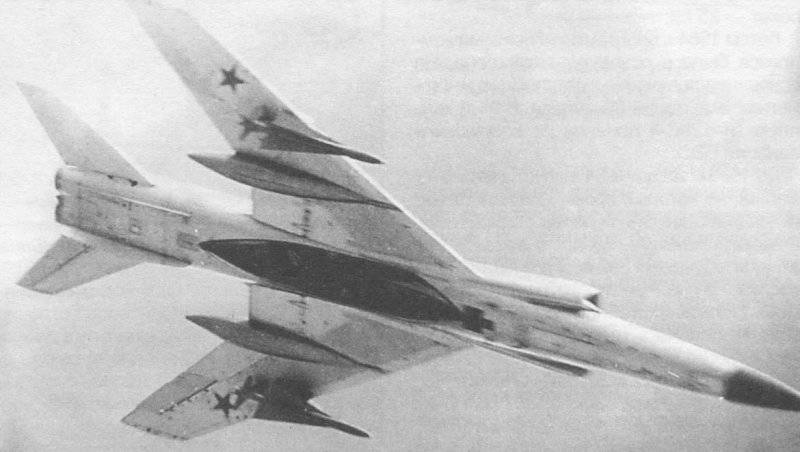



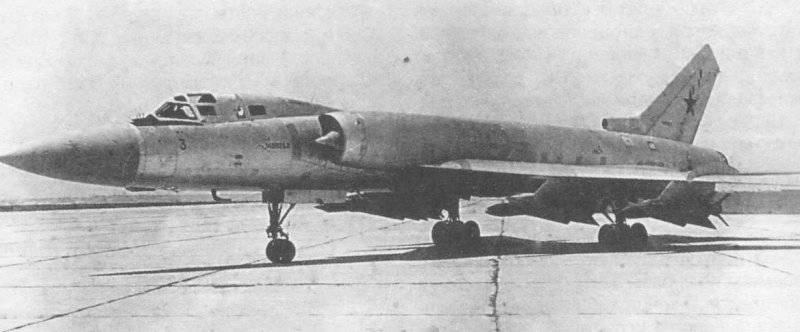

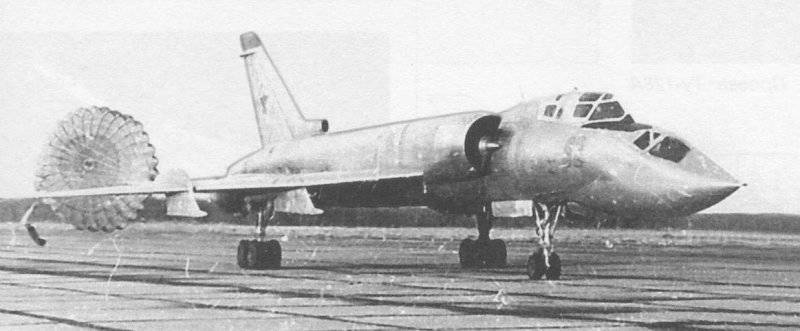
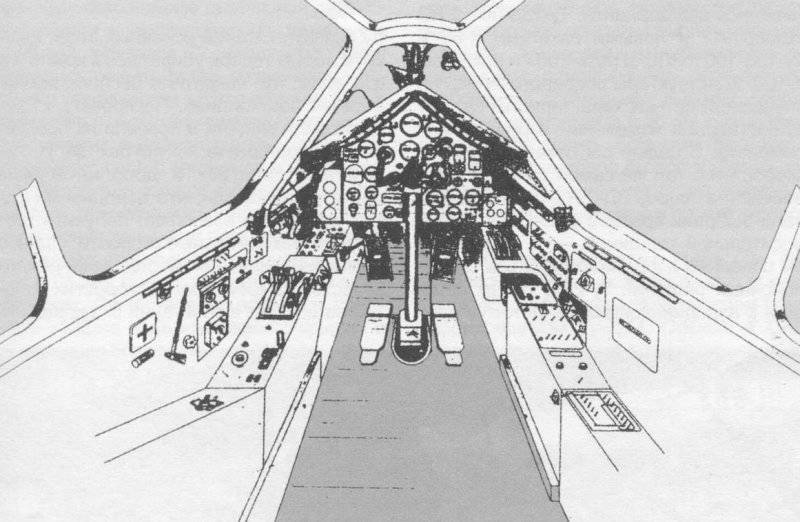
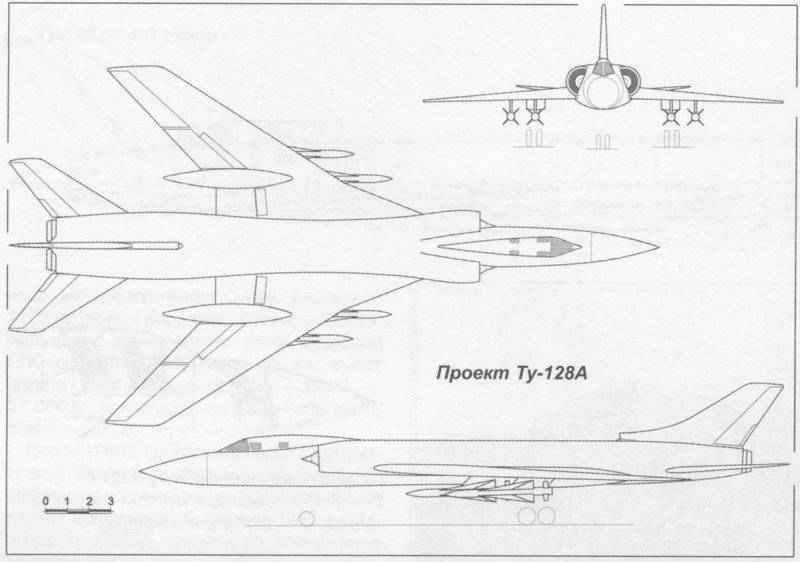
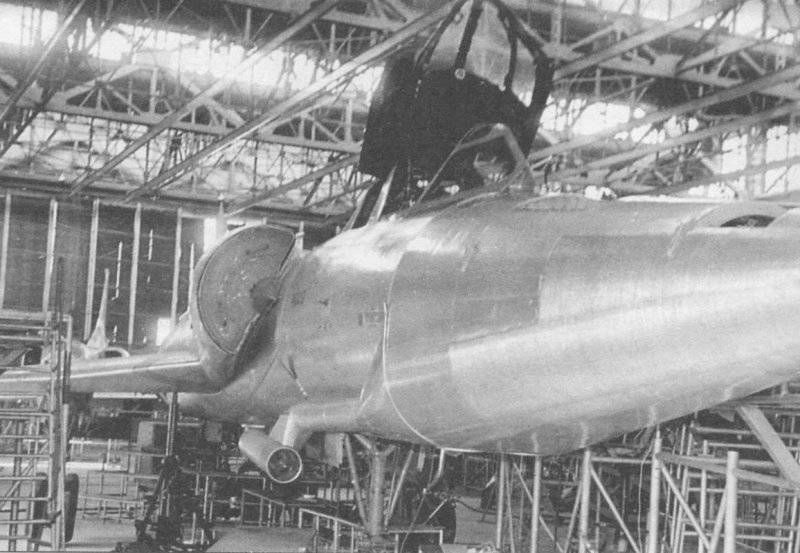


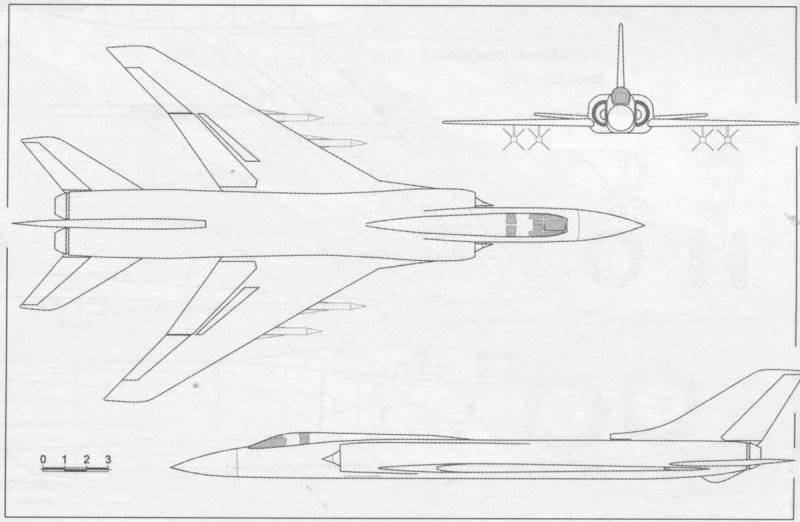

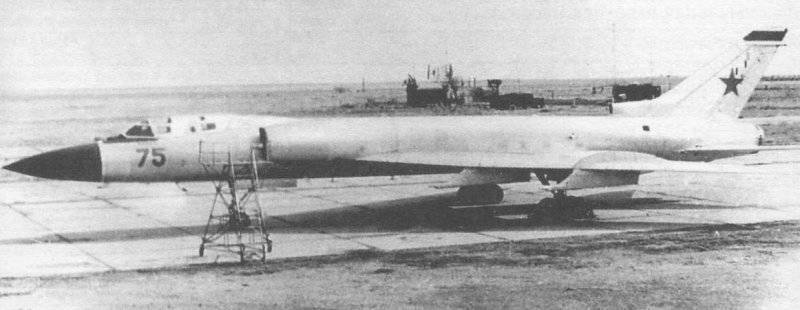
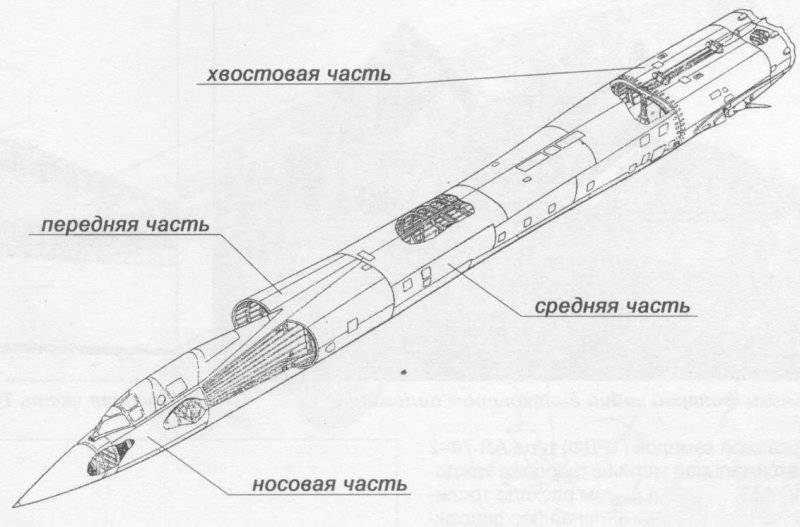
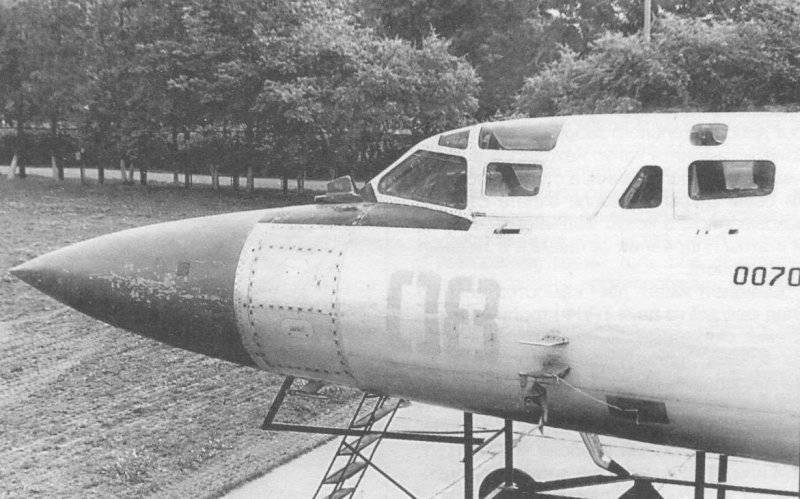
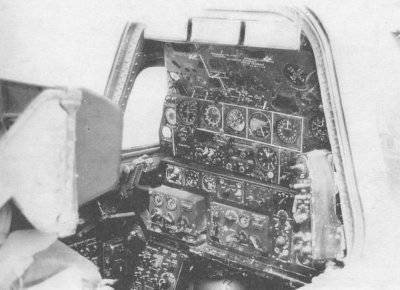
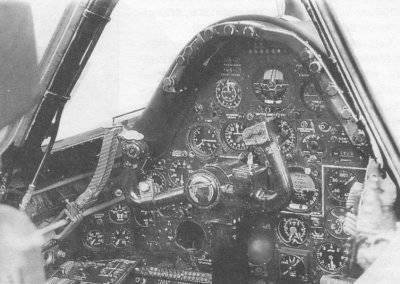
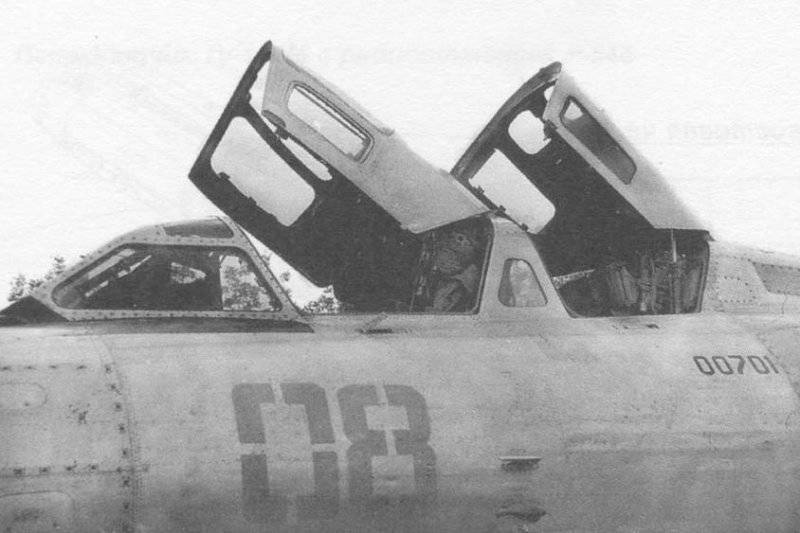
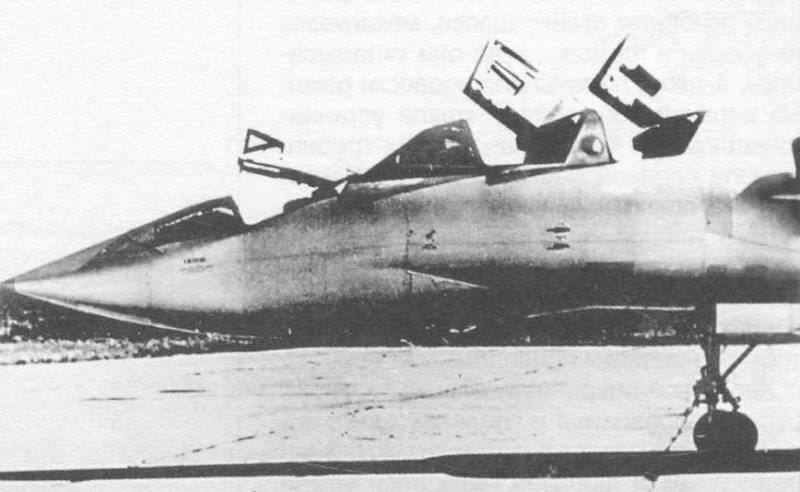
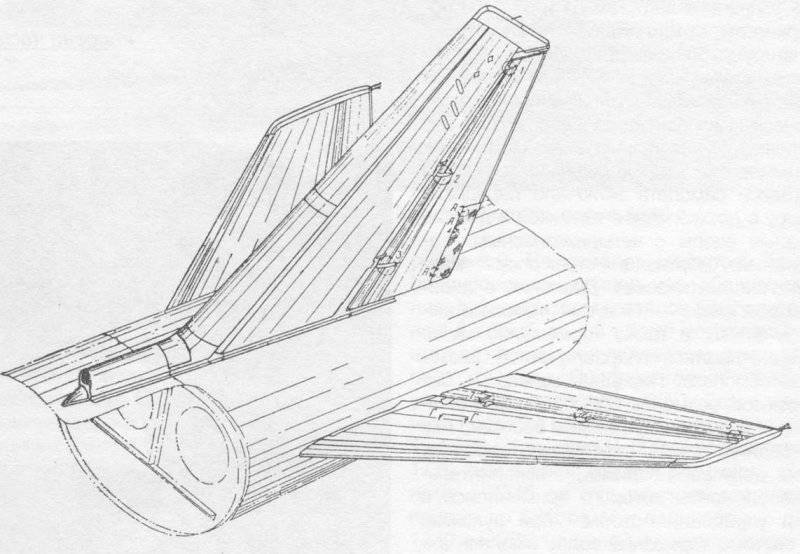
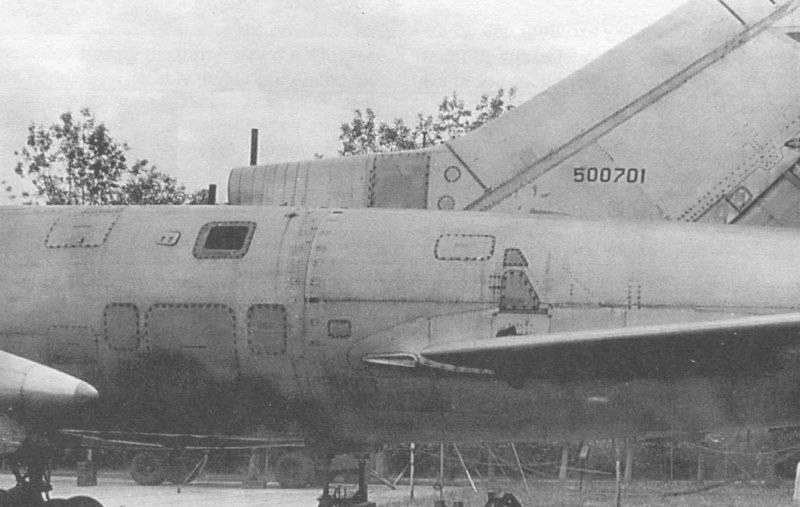
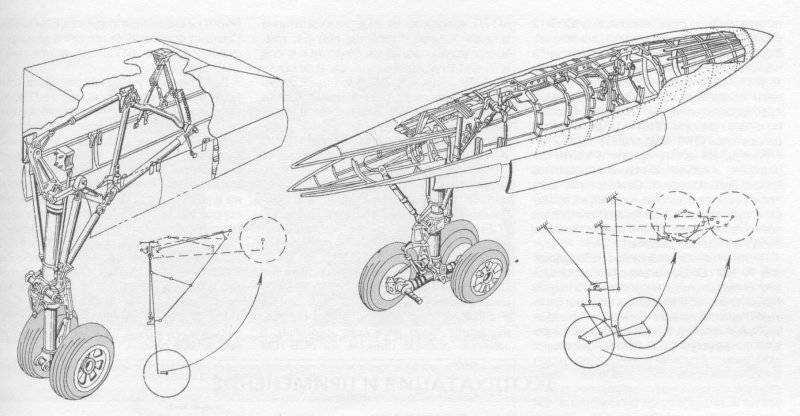
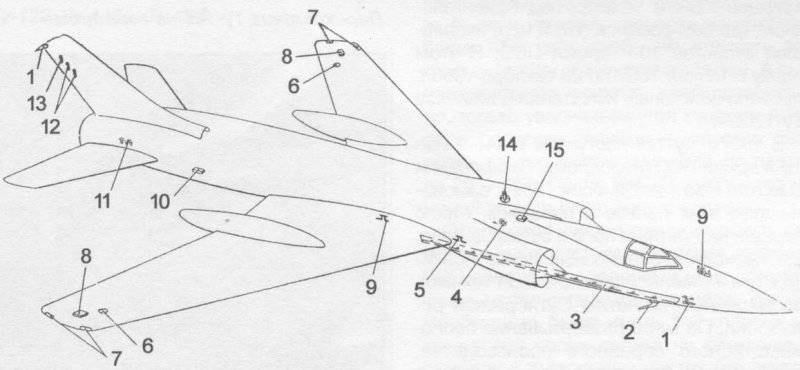
Information